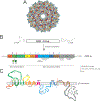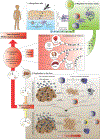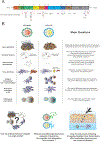Yellow Fever Virus: Knowledge Gaps Impeding the Fight Against an Old Foe
- PMID: 29933925
- PMCID: PMC6340642
- DOI: 10.1016/j.tim.2018.05.012
Yellow Fever Virus: Knowledge Gaps Impeding the Fight Against an Old Foe
Abstract
Yellow fever (YF) was one of the most dangerous infectious diseases of the 18th and 19th centuries, resulting in mass casualties in Africa and the Americas. The etiologic agent is yellow fever virus (YFV), and its live-attenuated form, YFV-17D, remains one of the most potent vaccines ever developed. During the first half of the 20th century, vaccination combined with mosquito control eradicated YFV transmission in urban areas. However, the recent 2016-2018 outbreaks in areas with historically low or no YFV activity have raised serious concerns for an estimated 400-500 million unvaccinated people who now live in at-risk areas. Once a forgotten disease, we highlight here that YF still represents a very real threat to human health and economies. As many gaps remain in our understanding of how YFV interacts with the human host and causes disease, there is an urgent need to address these knowledge gaps and propel YFV research forward.
Keywords: flaviviruses; viral pathogenesis; yellow fever; yellow fever vaccine; yellow fever virus.
Copyright © 2018 Elsevier Ltd. All rights reserved.
Figures





References
-
- Monath TP and Vasconcelos PF (2015) Yellow fever. Journal of clinical virology : the official publication of the Pan American Society for Clinical Virology 64, 160–173 - PubMed
-
- Quaresma JA, et al. (2013) Immunity and immune response, pathology and pathologic changes: progress and challenges in the immunopathology of yellow fever. Reviews in medical virology 23, 305–318 - PubMed
-
- Paules CI and Fauci AS (2017) Yellow Fever - Once Again on the Radar Screen in the Americas. The New England journal of medicine 376, 1397–1399 - PubMed
Resource section
-
- WHO Global Yellow Fever Data Base; http://apps.who.int/globalatlas/default.asp
-
- WHO (2016) Situation Report Yellow Fever - 28 October 2016; http://www.who.int/emergencies/yellow-fever/situation-reports/28-october...
-
- WHO/PAHO (2017) Epidemiological Update Yellow Fever - 10 July 2017. http://www.paho.org/hq/index.php?option=com_docman&task=doc_view&Itemid=...
-
- WHO – Disease outbreak news of January 22nd 2018; http://www.who.int/csr/don/22-january-2018-yellow-fever-brazil/en/
-
- WHO – Disease outbreak news of February 27th 2018; http://www.who.int/csr/don/27-february-2018-yellow-fever-brazil/en/
Publication types
MeSH terms
Substances
Grants and funding
LinkOut - more resources
Full Text Sources
Other Literature Sources
Research Materials

